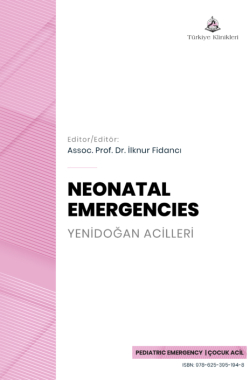Approach to Neonatal Seizures in the Pediatric Emergency Department
Dilek KAHVECİOĞLUa
aUniversity of Heatlh Sciences Ankara Training and Research Hospital, Clinic of Neonatology, Ankara, Türkiye
Kahvecioğlu D. Approach to neonatal seizures in the pediatric emergency department. In: Fidancı İ, ed. Neonatal Emergencies. 1st ed. Ankara: Türkiye Klinikleri; 2024. p.52-7.
ABSTRACT
Seizures occurring within 4 weeks after birth in full-term newborns or within 44 weeks of postmenstrual age in preterm infants are considered neonatal seizures. Seizures during the neonatal period are a medical emergency. Subtle seizures are the most prevalent type of neonatal seizures, with others clonic, tonic, and myoclonic seizures. In terms of long-term neurodevelopmental outcome, myoclonic seizures have the poorest prognosis. The most prevalent cause of neonatal seizures is hypoxic-ischemic encephalopathy in full term infants. Multiple etiologies frequently coexist in newborns, therefore it is critical to rule out diseases including hypoglycemia, hypocalcemia, and meningitis before beginning specific medication.
Keywords: Pediatric emergency medicine; infant, newborn; seizures
Kaynak Göster
Referanslar
- Pisani F, Facini C, Bianchi E, Giussani G, Piccolo B, Beghi E. Incidence of neonatal seizures, perinatal risk factors for epilepsy and mortality after neonatal seizures in the province of Parma, Italy. Epilepsia. 2018;59(9):1764-73. [Crossref] [PubMed]
- Neonatal Neurology. Vol. 162. In: de Vries LS, Glass HC, eds. 1st ed. Handbook of Clinical Neurology Series. 2019.
- Ramantani G, Schmitt B, Plecko B, Pressler RM, Wohlrab G, Klebermass-Schrehof K, et al. Neonatal Seizures-Are We there Yet? Neuropediatrics. 2019;50(5):280-93. [Crossref] [PubMed]
- Glass HC, Pham TN, Danielsen B, Towner D, Glidden D, Wu YW. Antenatal and intrapartum risk factors for seizures in term newborns: a population-based study, California 1998-2002. J Pediatr. 2009;154(1):24-8.e1. [Crossref] [PubMed] [PMC]
- Kohelet D, Shochat R, Lusky A, Reichman B; Israel Neonatal Network. Risk factors for seizures in very low birthweight infants with periventricular leukomalacia. J Child Neurol. 2006;21(11):965-70. [Crossref] [PubMed]
- Hall DA, Wadwa RP, Goldenberg NA, Norris JM. Maternal risk factors for term neonatal seizures: population-based study in Colorado, 1989-2003. J Child Neurol. 2006;21(9):795-8. [Crossref] [PubMed]
- Kohelet D, Shochat R, Lusky A, Reichman B; Israel Neonatal Network. Risk factors for neonatal seizures in very low birthweight infants: population-based survey. J Child Neurol. 2004;19(2):123-8. [Crossref] [PubMed]
- Yozawitz E. Neonatal Seizures. N Engl J Med. 2023;388(18):1692-700. [Crossref] [PubMed]
- Besnili Acar D, Bülbül A, Uslu S. Current Overview of Neonatal Convulsions. Med Bull Sisli Etfal Hosp. 2019;53(1):1-6. [Crossref] [PubMed] [PMC]
- Glass HC, Wusthoff CJ, Shellhaas RA, Tsuchida TN, Bonifacio SL, Cordeiro M, et al. Risk factors for EEG seizures in neonates treated with hypothermia: a multicenter cohort study. Neurology. 2014;82(14):1239-44. [Crossref] [PubMed] [PMC]
- Shellhaas RA, Chang T, Tsuchida T, Scher MS, Riviello JJ, Abend NS et al. The American clinical neurophysiology society's guideline on continuous electroencephalography monitoring in neonates. J Clin Neurophysiol. 2011;28(6):611-7. [Crossref] [PubMed]
- Yılmaz A, Tatar Aksoy H, Vurallı D. Neonatal Convulsions. Yenidoğan Konvülsiyonları. 2015;12(1):39-47.
- Van Hove JL, Lohr NJ. Metabolic and monogenic causes of seizures in neonates and young infants. Mol Genet Metab. 2011;104(3):214-30. [Crossref] [PubMed]
- Baxter P. Pyridoxine-dependent and pyridoxine-responsive seizures. Dev Med Child Neurol. 2001;43(6):416-20. [Crossref] [PubMed]
- Krawiec C, Anastasopoulou C. Nonketotic Hyperglycinemia. [Updated 2023 Mar 2]. In: StatPearls [Internet]. Treasure Island (FL): StatPearls Publishing; 2023 Jan-. Available from: [Link]
- Mosca S, Martins J, Temudo T. Transient benign paroxysmal movement disorders in infancy. Rev Neurol. 2022;74(4):135-40. English, Spanish. [Crossref] [PubMed]
- Gupta J, Badal S, Anand V, Jauhari P, Chakrabarty B, Gulati S. Hyperekplexia: A Frequent Near Miss in Infants and Young Children. Neurol India. 2022;70(1):312-4. [Crossref] [PubMed]
- Nguyen T, Wusthoff CJ. Clinical manifestations of neonatal seizures. Pediatr Int. 2021;63(6):631-5. [Crossref] [PubMed]
- Glass HC, Bonifacio SL, Sullivan J, Rogers E, Ferriero DM, Goldstein R, et al. Magnetic resonance imaging and ultrasound injury in preterm infants with seizures. J Child Neurol. 2009;24(9):1105-11. [Crossref] [PubMed] [PMC]
- Pressler RM, Abend NS, Auvin S, Boylan G, Brigo F, Cilio MR, et al. Treatment of seizures in the neonate: Guidelines and consensus-based recommendations-Special report from the ILAE Task Force on Neonatal Seizures. Epilepsia. 2023 Sep 1. [Crossref] [PubMed]
- Sharpe C, Reiner GE, Davis SL, Nespeca M, Gold JJ, Rasmussen M, et al.; NEOLEV2 INVESTIGATORS. Levetiracetam Versus Phenobarbital for Neonatal Seizures: A Randomized Controlled Trial. Pediatrics. 2020;145(6):e20193182. Erratum in: Pediatrics. 2021;147(1). [Crossref] [PubMed] [PMC]
- Miller SP, Weiss J, Barnwell A, Ferriero DM, Latal-Hajnal B, Ferrer-Rogers A, et al. Seizure-associated brain injury in term newborns with perinatal asphyxia. Neurology. 2002;58(4):542-8. [Crossref] [PubMed]
- Pisani F, Cerminara C, Fusco C, Sisti L. Neonatal status epilepticus vs recurrent neonatal seizures: clinical findings and outcome. Neurology. 2007;69(23):2177-85. [Crossref] [PubMed]
- Fitzgerald MP, Massey SL, Fung FW, Kessler SK, Abend NS. High electroencephalographic seizure exposure is associated with unfavorable outcomes in neonates with hypoxic-ischemic encephalopathy. Seizure. 2018;61:221-6. [Crossref] [PubMed] [PMC]
- Payne ET, Zhao XY, Frndova H, McBain K, Sharma R, Hutchison JS, et al. Seizure burden is independently associated with short term outcome in critically ill children. Brain. 2014;137(Pt 5):1429-38. [Crossref] [PubMed] [PMC]

